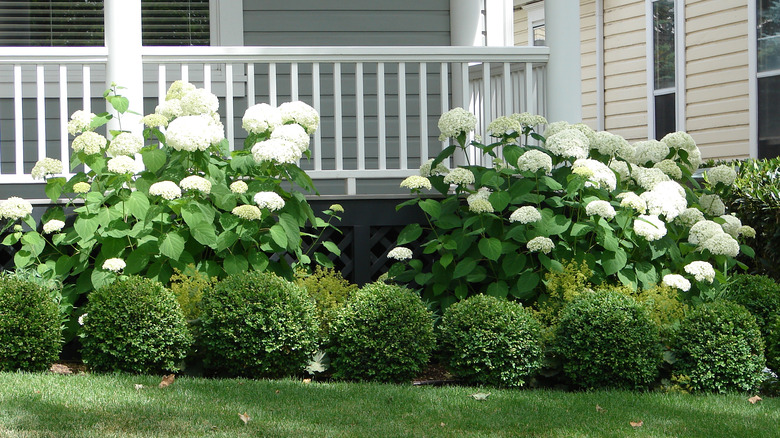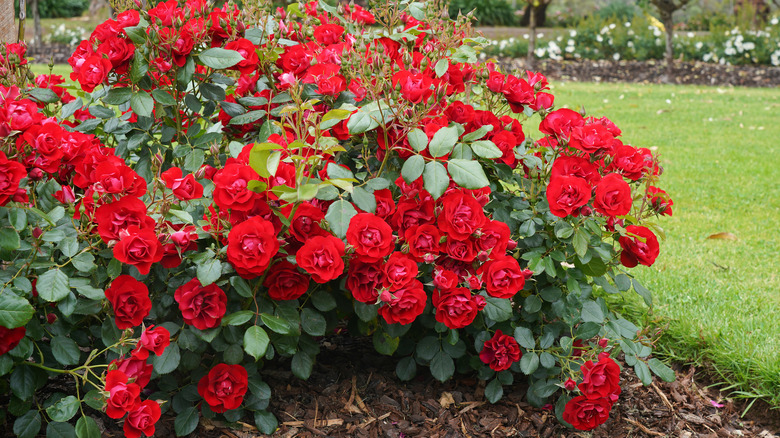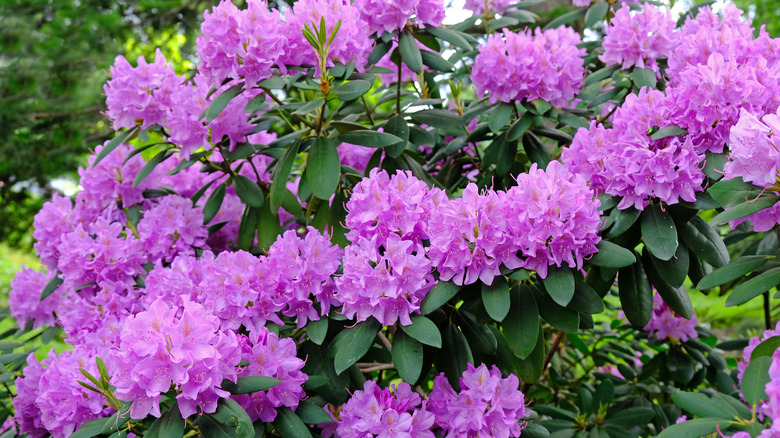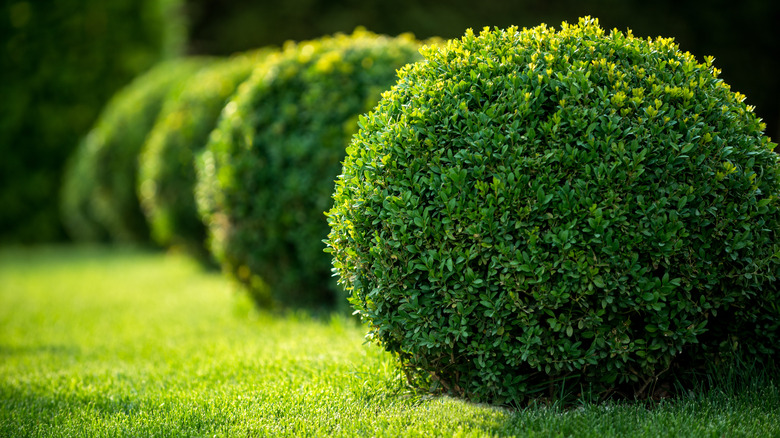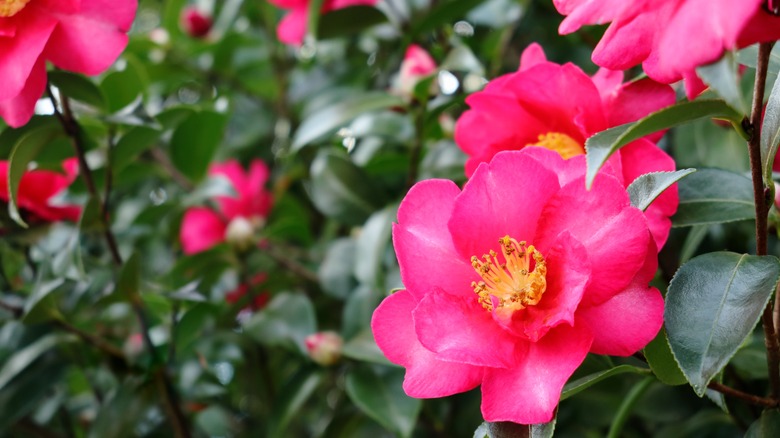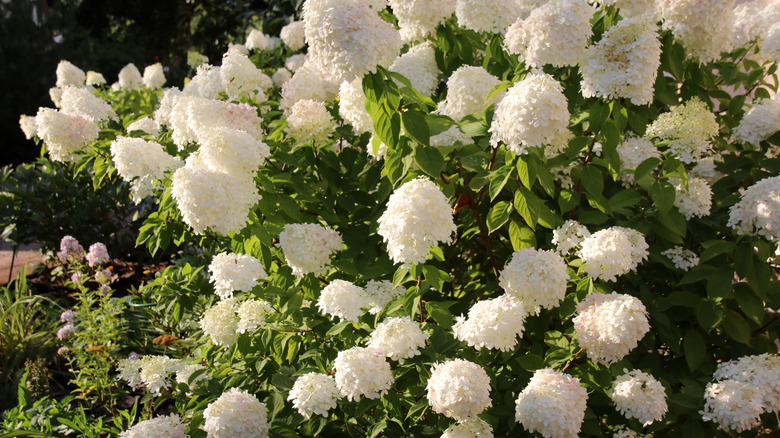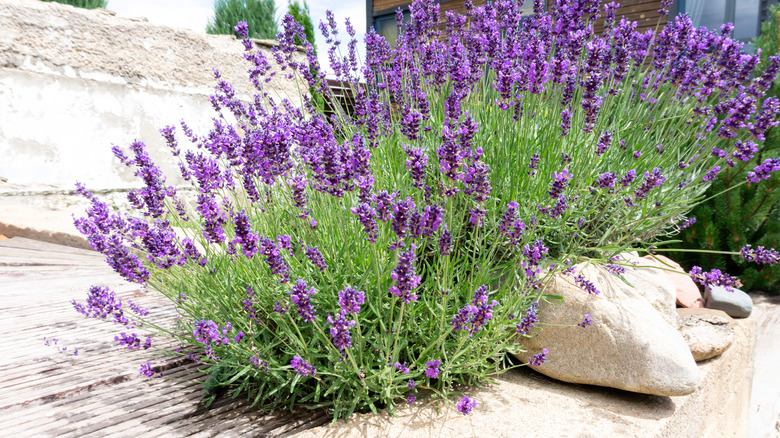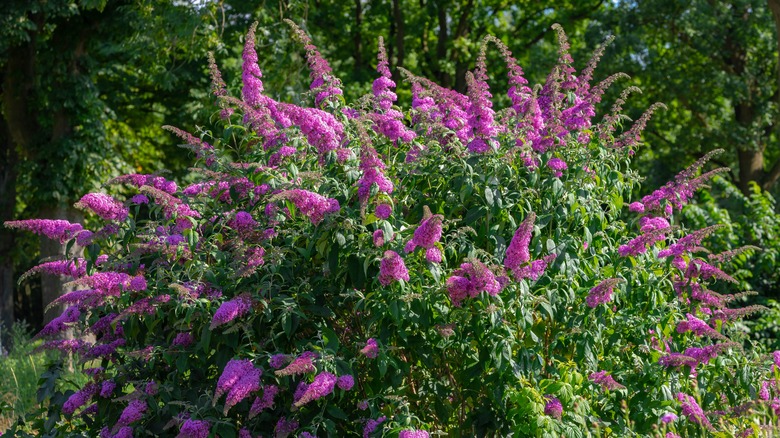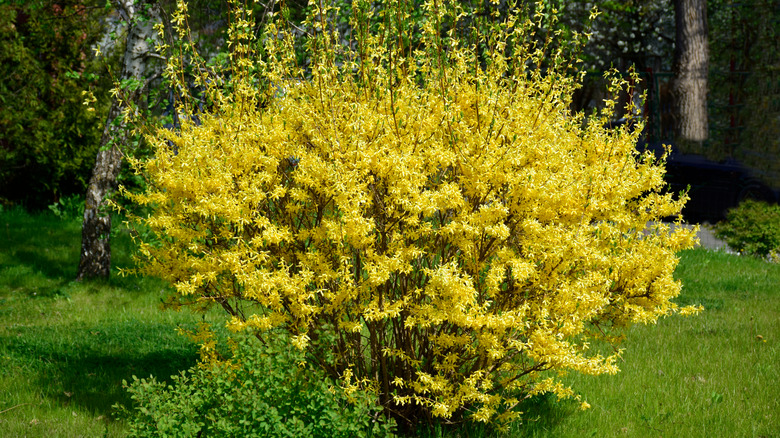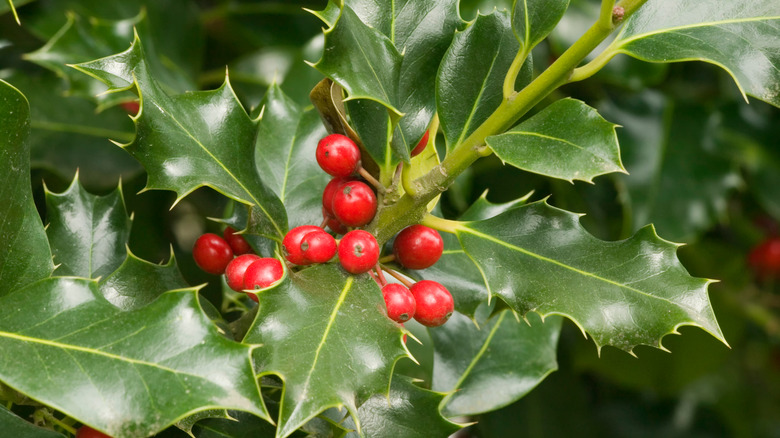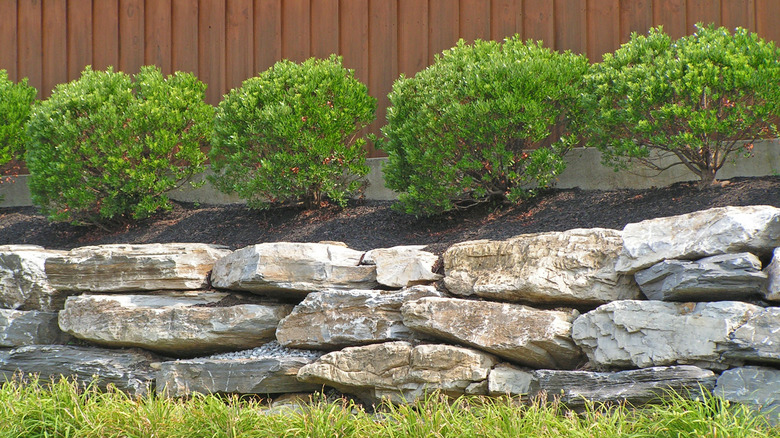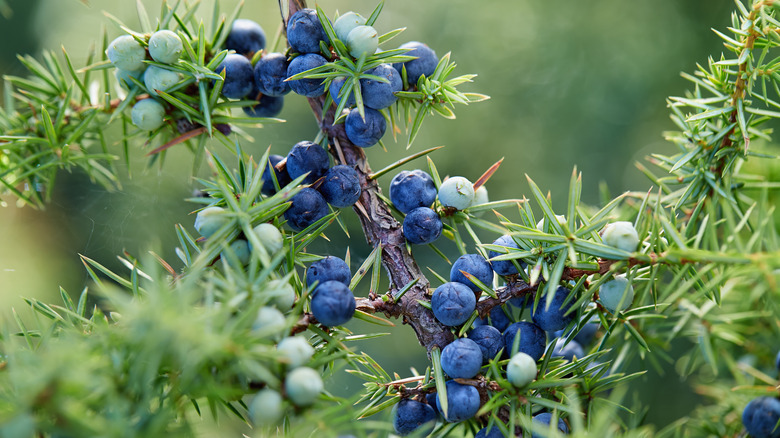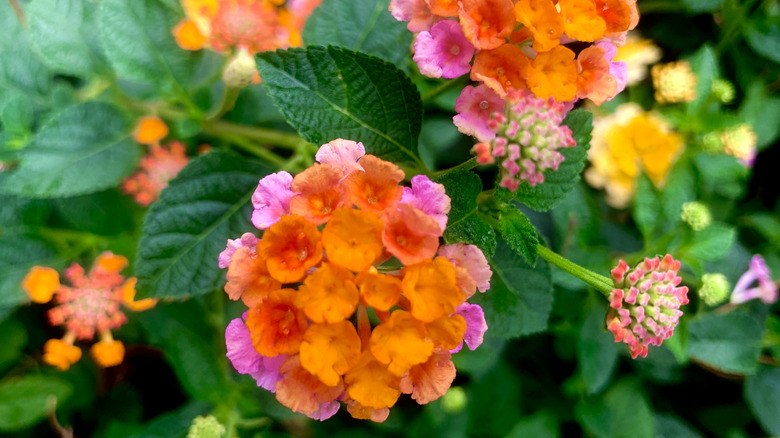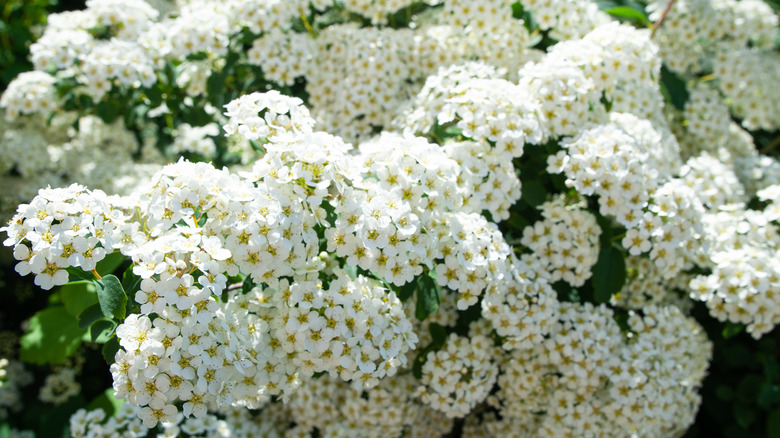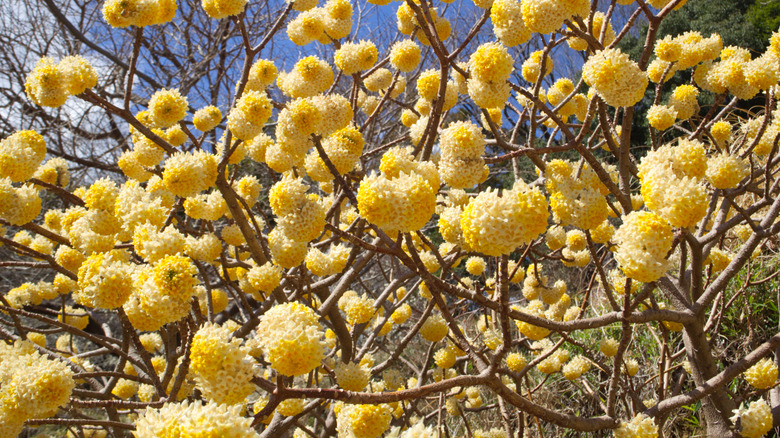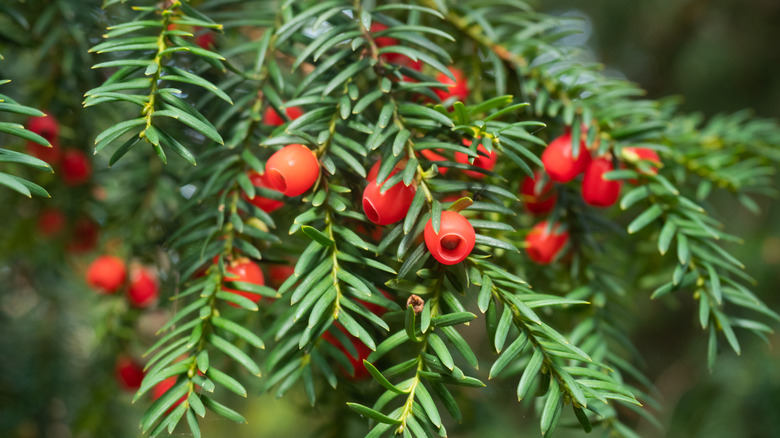The 15 Best Bushes To Plant In Front Of Your House
One thing many homeowners hate to see when designing the landscape outside their home is exposed foundation. There are various ways to hide it, from adding lattice to slapping on a coat of paint. However, landscaping professionals, such as New Roots Landscaping, agree that you should never cover up your foundation as it can lead to trapped moisture and cause problems down the road. Instead, you should consider planting bushes in front of your home's foundation to hide the concrete and beautify your front yard at the same time.
There are several great options for this project, from large camellia bushes to smaller boxwood shrubs, we're sure you'll find the bush that fits your needs. Most medium-sized bushes like those in our list suit many climates. They're also relatively neglect-tolerant and will do wonders in making the front of your home much more welcoming to guests.
Rose bushes
In general, the best kind of rose bushes you can plant outside your home are known as shrub roses or the floribunda rose — a hybrid between two other roses: polyantha (Rosa multiflora) and hybrid tea. As described by Jacksons Nurseries, floribunda rose bushes are bushy, stiff, and covered in clusters of flowers that show off fragrant, ruffled petals. The large flowers, which are often about 4 inches across, bloom from summer until fall when the bush is cared for properly.
Caring for floribunda roses is not too difficult. As per Midwest Gardening, the most important aspects to consider are sunlight, soil, and fertilization. These bushes, which are hardy to USDA zones 5 through 10, must have access to several hours of full sun daily. However, they also need protection from the wind. This is why they're such a good landscape rose for planting in front of your home.
Your rose bush will succeed if you plant it in rich, fertile, and well-drained soil. Keep in mind that floribunda roses also need plenty of moisture, so you'll want to set up a regular watering schedule. And, while you're at it, you can also set up a fertilization schedule, where you plan to feed your roses twice per year.
Azalea bushes
Azaleas (Rhododendron spp.) are a popular option due to their adaptive nature and ability to grow in USDA hardiness zones 5 through 9, as noted by Monrovia. Within the Rhododendron genus, there are more than 1,000 species that vary in size, color, bloom time, and care requirements. Depending on where you live, one Rhododendron will be better for your front lawn compared to another.
Before choosing your favorite, consider the place where you plan to grow yours. Azaleas enjoy partially shady spots with well-drained, organic soil that's not burdened with excess moisture, per Clemson's Home & Garden Information Center. When this plant is grown in soggy soil, it'll become more susceptible to diseases like root rot.
Fertilizer can be another important factor when growing azaleas. These bushes need plenty of nutrients to grow, but most of them can be introduced through its soil when the plant is young. You should only fertilize your azalea bushes when they show signs of nutrient deficiency such as yellowing leaves or a slow growth rate. When this happens, you can apply liquid fertilizer at the base of your plant during its growing season.
Boxwood shrubs
Boxwood shrubs (Buxus spp.) are known for their evergreen foliage and bushy growth habit. These popular landscape plants can be pruned into visually pleasing shapes such as spheres and rectangles, as shown by Total Landscape Care. Within the Buxus genus, there are at least 70 distinct species, but the most common species used in landscaping in the United States is the English boxwood or Buxus sempervirens.
This broadleaf evergreen is hardy to USDA growing zones 5 through 8, and it can grow in a variety of light conditions, per the Missouri Botanical Garden. When you provide your boxwood shrub with the right sort of care, it may grow up to 15 feet tall and wide. However, with diligent pruning, you can be certain that it stays the shape you prefer. When planting a shrub like this, you must grow it in well-draining, loamy soil where it won't be harmed by harsh winds or hot afternoon sun. Water it regularly and feed it balanced fertilizer in the late fall or early spring.
Camellia bushes
Camellia bushes (Camellia sasanqua) can be identified by their showstopping flowers, pleasant fragrance, and evergreen foliage (via Monrovia). There are many camellia species, however, this one, in particular, works well as a foundation plant in front of your home. Camellia sasanqua typically grows between 2 and 12 feet tall. Of course, it's unlikely that you would want a 12-foot tree in front of your living room window, but many cultivars in this species grow much smaller, such as the "Jean May" camellia or the "Plantation Pink" camellia.
According to the North Carolina Extension Gardener Plant Toolbox, the sasanqua species works well with other shrubs planted in your garden as their leaves are smaller and not very coarse. In order to successfully grow a blooming camellia bush, you will need to plant yours in acidic, well-drained, and organically rich soil. Adding a layer of mulch on top of the bush's roots will ensure it receives protection from the cold and plenty of nutrients. This landscape shrub also needs a protected, shady area. These bushes cannot tolerate full sun conditions or harsh winds.
Hydrangea bushes
Hydrangea bushes (Hydrangea paniculata) can be used in many ways on your lawn. They can be grown into trees, made into a focal point in your garden, or trained into hedges that line the front of your home. As noted by the North Carolina Extension Gardener Plant Toolbox, this particular species is recognized as one of the best hydrangea bushes to plant in colder regions of the U.S. It's hardy to USDA zones 4 through 8, and it can tolerate air pollution that's common in urban environments.
This multi-stemmed deciduous shrub won't need to be planted in any special soil, just be sure that it's well-draining but still moist. As per Miracle-Gro, you must consider water when planting hydrangeas; compared to other bushes, they require much more frequent watering, especially during the summer months. Their soil should be consistently moist. Furthermore, regular fertilization will also help your hydrangea bushes reach their full potential. Try to feed yours twice per year: once during the early spring and again later on in the summer.
Lavender bushes
Lavender (L. officinalis) is an excellent and low-growing shrub that will add a delightful scent to your yard. Even better, lavender is a fast grower, so if your plants seem a bit sparse for the first year, they'll fill out once they've become more established.
If you want to cultivate lavender in your flower beds, West Coast Seeds says to plant them in warm soil and start them as sprouts. Don't crowd them too much with mulch, as they don't like overly wet soil, which can cause root rot. Additionally, there are several different types of lavender; English lavender does well in USDA zone 5, for example, while Spanish lavender can thrive in zones 7 to 9.
The Pioneer Woman suggests pruning your lavender in the spring (rather than in the fall) the moment that you notice new growth. It does take some time before leaves start popping up, but you'll be rewarded for your patience.
Butterfly bush
It would be tough to go wrong with a butterfly bush (Buddleja davidii) adorning your front yard. Giant clusters of bright pink to lilac flowers cover this bush, which is basically guaranteed to attract butterflies. A single cluster of flowers, called a panicle, can be 18 inches long, and each individual blossom contained therein will have an orange center and delightful fragrance that will signal hummingbirds to pay a visit. Butterfly bushes bloom continually from summer into the late fall. However, they require a lot of sun to do so.
One butterfly bush typically grows up to 12 feet high and can spread as wide as 15 feet. Keep in mind, though, that this is a self-seeding shrub. That translates to vigorous growth, and it can potentially spread throughout the yard. To slow the growth of an overzealous butterfly bush, get outside to deadhead spent blooms before they can go to seed. A strong breeze is all this plant needs to move its seeds to the neighbor's yard.
Forsythia
For a swath of bright yellow that will make your yard look like it's been painted by the sun, consider planting forsythia bushes (Forsythia spp.). These shrubs grow quickly to form a rounded dome spreading up to 12 feet wide and 10 feet high. The striking bell-shaped flowers appear early in the season, trumpeting the arrival of spring. Hardy to USDA zones 3 through 8, forsythia is easy to grow and can adapt to most soil types. It is tolerant of deer and resistant to pesky Japanese beetles. This is a deciduous shrub, so it will lose its leaves in the winter.
One chore you will have to keep up with is pruning. Otherwise, a healthy forsythia bush is bound to grow a bit out of control by late summer. To keep yours in check, tend to it by late spring once the flowers have finished blooming. You can prune the oldest stems down to the base of the plant without fear of doing damage. A hardy forsythia will push forth new shoots that will grow for the rest of the season and be ready to flower the following spring.
Holly
Holly (Ilex aquifolium) is a gorgeous shrub whose well-known spiky green leaves and cardinal red berries are often used as decorations for the Christmas holidays. Holly makes a great choice for the front yard because it is evergreen and will offer a hedge full of color all year-round. The berries become ripe in the fall, giving you delicate pops of color just as the dreary winter sets in. A holly bush can grow incredibly tall (30 to 50 feet) and considerably wide (15 to 25 feet), so it's a good choice if you want to create a wall of privacy at the edge of your property.
Note that not all holly bushes will produce berries. This is because they are dioecious plants, meaning there are female and male varieties that need to be planted in close proximity to each other for pollination to occur. Also note that birds and other wildlife love the berries, but they're not good for humans to eat. For adults, ingesting the berries can cause gastrointestinal distress; for children, symptoms can be much worse.
Inkberry
The inkberry bush (Ilex glabra) is another evergreen member of the Ilex genus, of which there are at least 400 species. It is similar to holly though much smaller; an inkberry bush will top out at a maximum of 8 feet tall and can be easily pruned back to maintain a compact shape. The berries on this variety are black in color, and again, this is a dioecious plant, so if you only have one, you might find that it doesn't produce any berries. The oval-shaped leaves will still create a gorgeous ornamental piece worthy of a spot in front of the house.
In addition to pruning for shape, remove suckers as they start to grow. Failing to do so could result in an unruly shrub, or simply more plants than you bargained for. On the other hand, if you want more inkberry bushes to use in other parts of the landscape, be gentle when you remove the suckers and transplant them wherever you want to see new shrubs growing. However many you end up with, your inkberries should be relatively easy to maintain with a wide winter hardiness range of USDA zones 4 through 11.
Juniper
Fragrant evergreen junipers come from the cypress family and offer a few different options when it comes to ornamental bushes for the front yard. The blue star variety (Juniperus squamata 'Blue Star') is a low-lying shrub that appreciates well-draining soil and lots of direct sun. Juniperus horizontalis, this wispier creeper variety, is better for ground cover since it grows up to 8 feet wide. They are especially beneficial if you are struggling with soil erosion within your landscape. Juniper bushes prefer conditions to be slightly dry and cooler; they will not tolerate wet soil or particularly hot and humid climate zones.
Junipers don't flower, but some varieties will produce bright blue berries that are actually fleshy seed cones. These berries give gin its distinctive piney flavor, so they are drinkable and edible. They've been used medicinally for over 5,000 years, and creative home cooks might find that the berries work well in dishes ranging from pheasant to venison to jams and roasted potatoes.
Lantana
Bush lantanas (Lantana camara) like heat and full sun. In favorable conditions, they will bloom profusely throughout spring, summer, and fall in an array of bright pinks, oranges, and yellows. Lantanas generally grow in the 2 to 4 feet range, but some will expand to 5 or even 6 feet. They are perennial pollinator attractors that are tolerant to salt, drought, and a wide range of soil textures throughout USDA zones 7 to 11. The most important environmental aspect for a lantana is that it receives a minimum of 6 hours of sun per day.
It's important to note that most parts of this plant are toxic to humans because of the triterpenes present in the flowers, fruits, leaves, and sap. Wear pants, long sleeves, and gloves when pruning, and consult a doctor or poison control hotline if anyone accidentally ingests any part of a lantana plant. In this case, "anyone" refers to humans (especially children), cats, dogs, and horses.
Meadowsweet
For the ultimate front yard botanical display, try to get your hands on a spirea meadowsweet bush (Spiraea alba). They're deciduous, so they won't offer much in the wintertime, but when they explode with blossoms in the summer, your house will be the most talked about on the block. And butterflies will arrive in droves to check them out. Meadowsweet bushes grow between 3 and 4 feet tall with the same amount of width. Native to the east coast and Midwest, they like full sun exposure but can handle some shade.
A bonus with these is that they are flowering plants that thrive in soggy soil. In fact, they need the extra moisture and cannot tolerate a dry landscape. That makes them adaptable to a rain garden or any spot in your yard with heavy water runoff from the gutters. To keep your meadowsweet blooming for a full season, deadhead spent blossoms once they start to dry out.
Paperbush
The botanical name Edgeworthia chrysantha might lead you to think the paperbush is the most worthy option for lining the edges of your front yard, but it actually comes from Irish botanist Michael Pakenham Edgeworth. Even so, the paperbush is a unique and delightful option for the yard, with golden clusters of lollipop-like flowers at the ends of each stem. Not only are they gorgeous, but the blooms are also fragrant and attractive to bees, butterflies, and other pollinators. Once the season shifts into summer, the blossoms will give way to oblong, tapering leaves with a color some will describe as green, others blue, and still others silvery. By autumn, the leaves will turn their own shade of yellow before falling from the bush for winter.
Your paperbush shrub will max out between 4 and 6 feet tall and wide, stretching into a satisfying rounded dome-like shape. It will thrive in either a lot or a little sun, but make sure the soil is chock full of organic matter like compost. Interestingly, the common name of paperbush comes from the fact that the flowers can be made into paper. The paper is of such high quality that it is used to make currency in Japan.
Yew
If you like the red-berried evergreen look, you could also consider a yew shrub (Taxus baccata), but it's important to pay attention to the specific varietal because some grow to become 60-foot tall trees. Seek out a reputable nursery and invest in a specimen from the dwarf categories to create a lovely hedgerow or singular statement piece along a front porch. Compact yews such as 'Repandens' and 'Densa' grow to around 4 feet tall. Then there's the 'Emerald Spreader' that is more of a ground cover than a bush, and will fan out at a height of 2 ½ feet. You can also find yew cultivars that produce showy yellow foliage. They're all easy to maintain. Yews are shade-tolerant and can thrive in nutrient-poor soil.
The red berries of these bushes are technically referred to as arils, similar to what you find when you crack open a pomegranate. Yew berries are edible, but it's imperative that you spit out the seed after removing the flesh of the aril, or else you may be in for some gastrointestinal distress. If you happen to live on a cattle ranch, the yew bush is not for you. Its leaves can be fatal to cows when ingested.
